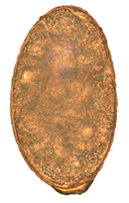
Trematoda is a class of flatworms known as flukes or trematodes. They are obligate internal parasites with a complex life cycle requiring at least two hosts. The intermediate host, in which asexual reproduction occurs, is usually a snail. The definitive host, where the flukes sexually reproduce, is a vertebrate. Infection by trematodes can cause disease in all five traditional vertebrate classes: mammals, birds, amphibians, reptiles, and fish.

Fasciolopsiasis results from an infection by the trematode Fasciolopsis buski, the largest intestinal fluke of humans, growing up to 7.5 cm (3.0 in) long.
Microphallus is a genus of parasitic trematodes (flukes) in the family Microphallidae. The Greek name means "tiny penis".
Laurer's canal is a part of the reproductive system of trematodes, analogous to the vagina. Trematodes are a class of worm-like parasites divided into two subclasses, Aspidogastrea and Digenea. In Digeneans, Laurer's canal opens from the dorsal surface of the body. In some Aspidogastreans, the canal ends in a blind ended sac. Laurer's canal may be used by the flukes during copulation, but more normally sperm enters the female system via the common genital atrium,, either during copulation, or self-fertilisation.

Trematodes are parasitic flatworms of the class Trematoda, specifically parasitic flukes with two suckers: one ventral and the other oral. Trematodes are covered by a tegument, that protects the organism from the environment by providing secretory and absorptive functions.

Echinostoma is a genus of trematodes (flukes), which can infect both humans and other animals. These intestinal flukes have a three-host life cycle with snails or other aquatic organisms as intermediate hosts, and a variety of animals, including humans, as their definitive hosts.
Australian Biological Resources Study (ABRS) is a project undertaken by the Parks Australia Division of Australia's Department of Climate Change, Energy, the Environment and Water.

Liver fluke is a collective name of a polyphyletic group of parasitic trematodes under the phylum Platyhelminthes. They are principally parasites of the liver of various mammals, including humans. Capable of moving along the blood circulation, they can occur also in bile ducts, gallbladder, and liver parenchyma. In these organs, they produce pathological lesions leading to parasitic diseases. They have complex life cycles requiring two or three different hosts, with free-living larval stages in water.

The forest shrew is a species of shrew in the mouse shrew family, Soricidae. It is found in Lesotho, South Africa, and Eswatini. Its natural habitats include temperate forests, dry savanna, Mediterranean-type shrubby vegetation, and temperate grassland. The term "forest shrews" in the plural is sometimes confusingly used to collectively refer to a different genus, Sylvisorex.
Cyclocoelidae is a family of trematodes in the order Plagiorchiida.

Nanophyetus salmincola is a food-borne intestinal trematode parasite prevalent on the Pacific Northwest coast. The species may be the most common trematode endemic to the United States.

Microcotyle is a genus which belongs to the phylum Platyhelminthes and class Monogenea. Species of Microcotyle are ectoparasites that affect their host by attaching themselves as larvae on the gills of the fish and grow into adult stage. This larval stage is called oncomiracidium, and is characterized as free swimming and ciliated.

Gyrodactylidae is a family of flatworms in the order Gyrodactylidea.

Opecoelidae is a family of trematodes. It is the largest digenean family with over 90 genera and nearly 900 species, almost solely found in marine and freshwater teleost fishes. It was considered by Bray et al. to belong in the superfamily Opecoeloidea Ozaki, 1925 or the Brachycladioidea Odhner, 1905.
Pseudopecoeloides is a genus of trematodes in the family Opecoelidae.

The Diplectanidae are a family of monopisthocotylean monogeneans. They are all parasitic on the gills of fish. Diplectanids are small animals, generally around 1 mm in length. As parasites, they can be extremely numerous, up to several thousand on an individual fish.

Satyu Yamaguti was a Japanese parasitologist, entomologist, and helminthologist. He was a specialist of mosquitoes and helminths such as digeneans, monogeneans, cestodes, acanthocephalans and nematodes. He also worked on the parasitic crustaceans Copepoda and Branchiura. Satyu Yamaguti wrote more than 60 scientific papers and, more importantly, several huge monographs which are still in use by scientists all over the world and were cited over 1,000 times each.
Telorchis is a genus of trematode parasites found in many herps, comprising around 70 species. This parasite is an indirect parasite, with a snail intermediate host and a reptile or amphibian definitive host. Typically found in the gastrointestinal tract of their definitive host, telorchids attach to the wall of the intestinal tract with their ventral sucker, or acetabulum.
Transversotrematidae is a family of trematodes in the order Plagiorchiida. It is the only family in the superfamily Transversotrematoidea, which is the only superfmaily in the suborder Transversotremata. It has been synonymised with Circuitiocoeliidae Wang, 1981, Squamacolidae Pan & Wang, 1985, and Transversotrematinae Witenberg, 1944.

Diplostomidae is a family of trematodes in the order Diplostomida.












